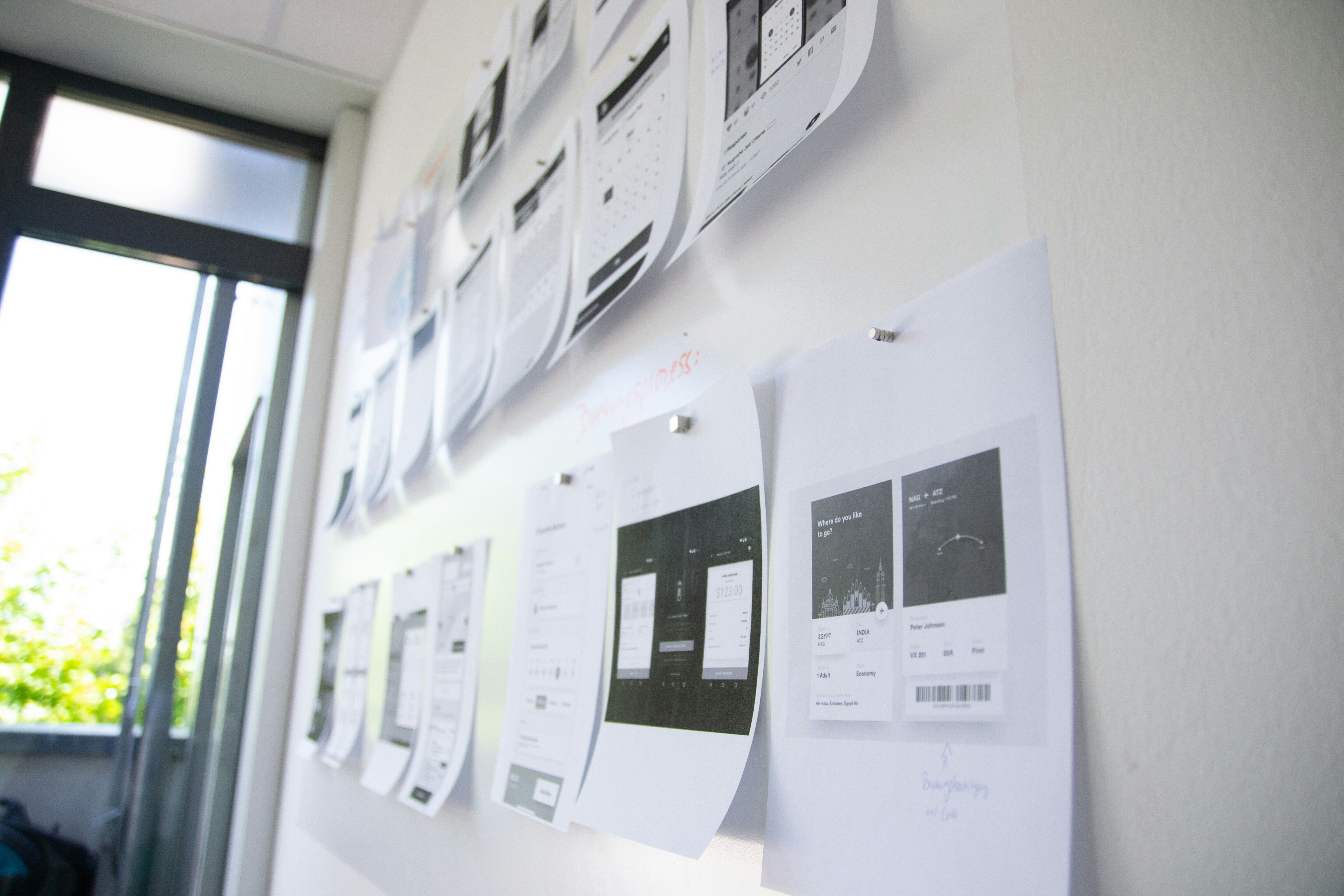The MVP Advantage: Launching Your Product with Confidence
Launching a successful product is challenging, but it doesn't have to be a gamble. There is a way to test the waters, validate your idea, and gather...
13 min read
Written by Keith Shields, Jul 31, 2025

Launching a minimum viable product (MVP) allows businesses to test the market before committing to a full-scale app or software build. Positioned after a proof-of-concept (POC) and prototype but before refining the final product, an MVP offers a lean, iterative approach to product development.
Despite being a relatively conservative step, an MVP still requires funding. Considering about one-third of startups fail because they run out of cash, businesses must budget accurately for MVP development.
Estimating costs before an MVP build helps founders avoid hidden expenses and plan for a lean launch. In this article, we’ll break down MVP development costs, identify key cost drivers, and offer budgeting tips effectively.
The cost of building an MVP varies widely, ranging from $10,000 on the low end to $400,000 or more on the high end. The true answer to “How much does it cost to build an MVP?” is, “It depends.” Here’s a quick breakdown:
Basic MVPs
Moderate MVPs
Complex MVPs
To find out where your project lands on this broad spectrum of development cost, you must understand which app elements act as price levers, pushing costs up or down. In the following sections, we’ll explore these key factors and offer clear examples to help you zero in on a precise budget.
→ Build the ideal MVP for your app with The SolutionLab
Generally speaking, the cost of MVP development increases with complexity. That means a high-complexity app with lots of features will be more expensive than a simpler one. For example, an MVP for an employee resource planning (ERP) app that requires integration with other systems will almost certainly cost more than a basic fitness tracker app with limited functionality.
To assess how simple or complicated your MVP is, think of complexity in three buckets: basic, moderate, and high.
Remember, an MVP should, by definition, include only essential features. Future iterations may add complexity with new features; however, unnecessary functionality at this stage can waste valuable resources and slow development.
Learn More: MVP Development: Formula to Learn What Features to Build into Your MVP
Intuitively, it makes sense that higher MVP complexity leads to higher development costs. Including complex features, like proprietary technology and database integration, requires more developer time. These additional hours increase labor costs. Likewise, some complex features might necessitate the help of a specialized expert, which also adds to the price of labor.
An MVP is an exercise in restraint. When there’s a vision for what an app could be, building it right from the start is tempting. Instead, start with a minimal version, then add features based on user feedback and business priorities. Restricting the MVP to only the essential features allows stewards to limit funds wisely and reduce risk.
Pro tip: Work closely with developers to identify features critical for launch and save “nice-to-haves” for future iterations.
Learn More: The MVP Advantage: Launching Your Product with Confidence
While there’s no set rule for what qualifies as basic vs. complex MVP features, the latter tends to require specialized development expertise.
An MVP might be considered complex if it includes these features or qualities:
Some features seem simple at first glance but require deep expertise or long development hours, quietly increasing overall complexity and cost.
Explore Designli’s mobile app development services →
An MVP represents the first functional version of an app. Still, design is no less important for an MVP than for a more established app. An MVP’s user interface (UI) and user experience (UX) design inform how users respond. No matter how complex the features of an MVP, having a user-friendly interface strengthens user adoption and retention.
A budget-friendly MVP doesn't have to mean skimping on UX/UI design. However, you should expect to pay more for apps requiring unique design features. Consider these ways that MVP design choices can impact your budget.
As with other cost-related MVP decisions, it’s helpful to consider the product's goal and which essential features will provide value to users. Future iterations can always include additional design features.
Designing an MVP requires balance. Aim for an application that balances both usability and cost. Your MVP probably won’t win any design awards, and that’s okay. Focus on delivering a clean, intuitive design rather than a highly customized look. Before pursuing a responsive or cross-platform development approach, consider which platforms or devices are the highest priority. In many cases, leveraging cross-platform frameworks can be an asset to your app’s success. However, choosing just one platform is sufficient.
Learn More: Cross-Platform App Development for Startups: Is It the Right Fit for Your App?
Yes, MVP design choices can affect cost. The best way to minimize design-related expenses is to carefully aim for a functional yet straightforward UI and choose launch platforms. While custom UI and animations might be essential for some MVPs, most can afford to incorporate design enhancements in future iterations when user feedback validates the need for such upgrades.
Learn more: 10 UI Design Principles for Business Success in Mobile Apps
A technology stack—that is, the programming languages, frameworks, and tools used in development—has important implications, both on cost and the future of your business. The right tech stack balances both affordability and scalability. Be sure to do thorough research on all your options.
Learn More: The Ultimate Guide to Choosing the Best Tech Stack for Your Product
When building an MVP tech stack, you’ll encounter several choices. Each type of tech stack offers benefits, but some are more costly than others.
Some tech stacks boast cult-like popularity, but that should not be enough to make your choice. Be sure to weigh the short- and long-term costs of choosing one stack or another. For example, the MEAN tech stack—MongoDB, Express.js, Angular, and Node.js—leverages fully open-sourced technologies, making it a cost-efficient. By contrast, the WISA tech stack—Windows Server, Internet Information Services (IIS), SQL Server, and ASP.NET—can become quite expensive over time.
When it comes to your tech stack, it’s important to take a holistic view of cost. What’s cheapest today might not be the most cost-efficient long-term. This is particularly true if your tech stack limits future growth. Look for solutions that accommodate today’s budget and technical requirements while leaving the door open for growth down the road. If you anticipate the need to scale up your operations in the future, choose a tech stack that prioritizes scalability and flexibility.
A cost-effective MVP tech stack typically includes a mix of open-source, cross-platform, and cloud technologies.
Learn More: Navigating the Cross-Platform App Development Landscape: A Comprehensive Guide to Frameworks
The team you choose for MVP development directly impacts costs. The best model balances business needs with budget. Whether you choose an in-house, outsourced, or hybrid model, understand the tradeoffs of each first.
Even a focused development effort like an MVP requires several key roles.
Each team member brings a specific expertise and serves an important function in the development process.
Hiring individual freelancers is often the most affordable option, but usually requires significant oversight. An agency offers a reliable medium between freelancers and an in-house team. The right development partner provides a straightforward process plus a solid team of experts at a fraction of the price of an in-house team. Building up an internal team offers the highest degree of control, but tends to be the most expensive development team structure.
As with your app, a lean approach will save you from unnecessary spending. Try starting with a small team that only has the essential roles. A small but high-quality team will often get you further than a large team of questionable talent. Remember, you can always hire additional team members and development specialists later.
In the absence of an existing in-house development team, outsourcing is typically the best approach to manage MVP price. A partnership with a development agency allows you to “turn on” the development team whenever needed, without having to worry about employee costs like training, office space, salaries, or benefits. In addition to upfront cost, also consider your business goals, timelines, scalability needs, and preferences for control when choosing between in-house or outsourced teams.
Learn More: Outsource vs. In-House Software Development: Making the Right Choice for Your Business
Testing and iteration are a vital part of MVP development. Releasing a well-tested, functional product increases your chances of achieving early adopter satisfaction and gaining traction. On the other hand, failing to prioritize iteration and testing steps can result in bugs, security incidents, or service interruptions, jeopardizing business success.
Testing for MVPs includes two critical rounds, alpha and beta testing, each of which informs early product iterations.
Alpha Testing
Beta Testing
Iterations
Each testing phase, alpha, beta, and post-launch iterations, adds to your MVP’s development cost. But skipping any step risks poor user adoption. Budgeting for MVP testing and iteration is essential to deliver a functional, user-validated product that’s ready to scale.
Initial testing usually isn’t a significant expense compared to testing later on in the iterative process. Often, however, it’s not the testing itself that contributes to development cost as much as the iterations that stem from feedback. If an MVP requires frequent adjustments, expect more development expenses. Relatively small updates, like simple feature additions or color changes, likely won’t pose a huge financial burden, but iterations that add complexity can get costly quickly.
To avoid surprises, allocate a portion of your MVP development budget for bug fixes, minor updates, and scalability improvements. This makes sure you can address user feedback quickly and with adequate iterations. User satisfaction is critical for gaining momentum, especially in the beginning.
The cost of testing and iteration varies based on various factors, including the kind of testing, the complexity of the app, and the type of iterations. Hiring a team to conduct user testing, for example, will be more costly than straightforward alpha testing focusing on glaring issues. Likewise, iterations that require advanced development techniques, like unstructured workflows or connecting to APIs, will cost more than simple cosmetic changes. You don’t necessarily need to spend much money to embrace the agile development methodology. Working with an experienced development partner can help you solicit and respond to feedback while managing limited funds.
Refining your MVP is essential, but rushing it can backfire. Avoid these common pitfalls to ensure that every update moves your product forward, not sideways.
Without proper planning, hidden costs can quickly derail an MVP budget. Hidden costs are fees and expenses that aren’t apparent in the development process but are still vital for success. App store fees, such as those Apple and Google charge for launching iOS and Android apps, are one typical example of a hidden cost. Other examples include legal fees or promotional expenses. Anticipating hidden costs is crucial since they can quickly add up and become a significant expense.
There are many categories of hidden costs, but not every type applies to every app. Knowing what to look for can help determine which hidden costs could affect your MVP development process.
Common MVP cost overruns include:
It’s a good idea to reserve a portion of your MVP development budget specifically for hidden costs. Consider which types of hidden costs apply to your MVP so that you can include an appropriate budget buffer to use if needed. Some experts recommend earmarking about 20 percent of your development budget to cover unexpected legal or technical expenses.
The best way to budget for hidden costs is to understand common types of hidden costs and anticipate them before your project kicks off. Most hidden costs are directly tied to your MVP’s technology stack and intended platforms, which tend to be transparent about their cost structure. For example, many pay-as-you-go cloud platforms publish price calculators to help developers estimate licensing fees based on expected usage. Researching these costs can help you build a comfortable budget with enough margin. Researching these costs can help you build a comfortable budget with enough margin.
Here’s a summary table to review the six key factors that impact the cost of your MVP:
-png.png?width=6780&height=6000&name=1200%20x%20628%20px%20(4)-png.png)
AI tools and no-code/low-code platforms are revolutionizing the MVP landscape by lowering the development barriers to entry. They are also reshaping MVP testing and updates by making this process faster, boosting productivity. However, they come with unique trade-offs, pitfalls like scalability limitations, customization roadblocks, and hidden long-term costs.
When it comes to your MVP, always start with clear goals. If your priority is validating a few core features, AI and no-code tools can offer a fast, cost-effective solution. However, for products aiming for investor buy-in and long-term scalability, a fully custom MVP is essential, regardless of the cost.
The average MVP cost in 2025 ranges from $20,000 to $150,000, depending on the project’s complexity, team structure, and required features. Basic MVPs can cost as little as $10K, while complex ones with AI, APIs, or custom integrations can exceed $400K.
Yes, startups can build lean MVPs under $50,000 by prioritizing core features, using open-source frameworks, and partnering with outsourced development teams.
Feature complexity, custom UI/UX design, tech stack choice, and team structure (in-house vs. agency) can all increase expenses. Iteration cycles and post-launch testing can also increase costs.
AI-assisted development and no-code/low-code platforms can cut MVP costs by 40–60%, especially for simpler apps. However, they often limit customization and scalability.
Creating an MVP is pivotal in turning a vision into a scalable, revenue-generating product. Every dollar should help you get closer to validation, traction, and investor readiness. You minimize surprises by budgeting, complexity, design requirements, technology stack, team structure, iteration, and testing. Most importantly, prioritize only the most essential features. The time and effort it takes to nail down a clear MVP cost range pays off. A well-planned MVP offers a foundation for future growth by serving as a tool to collect worthwhile insights.
Ready to build an MVP that matches your goals, vision, and budget?
Whether you're testing a concept or planning for scale, we help you align strategy, scope, and spending for more innovative MVP development. Helping our clients navigate all the MVP decisions and take the next step toward their business goals. Schedule a free consultation to discover more.
Explore Designli's UX/UI Design Services →
You might also like:
Subscribe to our newsletter.

Launching a successful product is challenging, but it doesn't have to be a gamble. There is a way to test the waters, validate your idea, and gather...

The first steps in your product development process are essential. Build a minimum viable product (MVP) to validate your software idea and gather...

In 2025, building an MVP looks very different from just a few years ago. Founders now have access to AI-assisted tools, rapid prototyping platforms,...
Post
Share